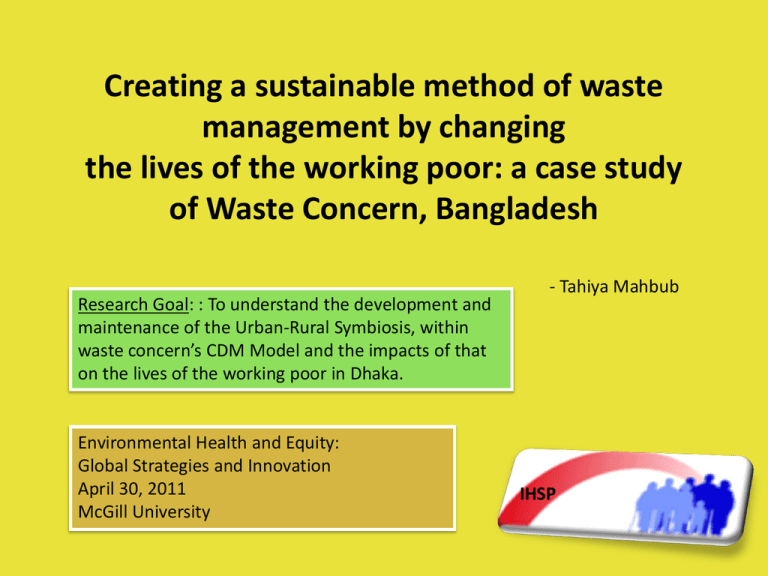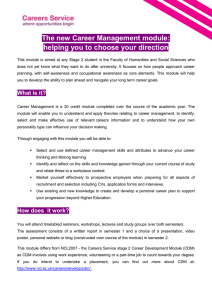Creating a sustainable method of waste management by changing
advertisement

Creating a sustainable method of waste management by changing the lives of the working poor: a case study of Waste Concern, Bangladesh Research Goal: : To understand the development and maintenance of the Urban-Rural Symbiosis, within waste concern’s CDM Model and the impacts of that on the lives of the working poor in Dhaka. Environmental Health and Equity: Global Strategies and Innovation April 30, 2011 McGill University - Tahiya Mahbub IHSP The status of solid waste management in Bangladesh • Every day the nearly 11 million people of Dhaka city produce around 3,500 tonnes of solid waste. • Dhaka City Corporation, (DCC) responsible for this enormous amount of waste is only able to collect approximately 42 per cent of the waste produced each day. • Waste is left to rot in the various dumping grounds located in and around the capital. Waste Concern • In this scenario, Waste Concern, founded in 1995 by A.H. Md. Maqsood Sinha and Iftekhar Enayetullah tackle the challenges of Waste Management in Dhaka, Bangladesh in a much more innovative and sustainable manner. • Company motto: WASTE IS A RESOURCE The focus of this case study was on the work of Waste Concern in partnership WWR Bio Fertilizer Bangladesh Ltd (a joint venture company of Waste Concern and World Wide Recycling BV, a Dutch Company). Maqsood Sinha Iftekhar Enayetullah (www.wasteconcern.org) My Case Study • My case study explores in detail the current main project of Waste Concern involving their largest endeavor till date. It is known as the Harnessing Clean Development Mechanism (CDM) for Composting Using Organic Waste • Under this project Waste Concern operates a 130-tonne-per-day capacity compost plant located in Bulta, Naranyanganj. • My questions are: GQ: In developing and maintaining the Urban-Rural Symbiosis, within the CDM Model, how does Waste Concern’s work impact the lives of the working poor in Dhaka? SQ1: How does the Urban-Rural Symbiosis, fit into Waste Concern’s CDM Model? SQ2: How does the CDM model contribute to the environmental aspects of urban development and sustainability in Dhaka city? SQ3: How are urban poor workers impacted by the CDM Model under which they work at the Bulta plant? On Bulta grounds with lab scientist Dr. Hena Methodology • Interpretivist Paradigm • A total of 30 semi-structured interviews were conducted between June-August 2009 at Waste Concern headquarters and plants, which were then recorded and transcribed word-for-word. • Observations were carried out at plants. • Gathered data was analyzed inductively. • Themes were generated from the findings. Workers near the bagging section. 3 pillars of CDM Innovative foreign Investment Financing Public-private cooperation (www.wasteconcern.org) People Involved -Consultants -Other businesses -Waste Concern -Plant Members of the Head Office busy at work with Bulta plant officials AIMS OF CDM • • • • • • • • Sustainable development for solid waste management. Create a demand for compost in Bangladesh Improve soil conditions and ensure food security. Impact the national agriculture policy of the country. Establishment of a large scale composting plant to recover organic wastes. Development of alternative solid waste management system to reduce the burden of waste on the municipality and the landfills. Create job opportunities Create a urban-rural symbiotic system of workable waste management for Bangladesh (Maqsood & Enayetullah, 2010) BASIC BULTA FACTS Operation since 25 November 2009 Plant area: 14,744 square meters Employment: 90 ppl (30CUR) Waste recycling capacity: 130 tonnes per day (70-80 CUR) The total cost of the CDM project is 12 million Euros (currently: 2.5 m) Annual income/revenue of Bulta 400,000 euros. From sale of compost: 285,700 euros Income from sale of CER (carbon emission reduction): 114,300 Monthly expenditure of Bulta plant is roughly 21,000 euros per month which includes salary and other expenditures. On a yearly basis, 148,000 euros approximately is profited from the Bulta plant. Bulta Plant in Pictures The major highway on which the plant is located in Bulta, Narayanganj. The entranceway of the plant. The office building can be seen on the left. The Bulta Plant gate and entrance. Bulta Plant in Pictures Pile of waste close to complete maturation at the Bulta Plant, where the land of the Plant is owned by the project itself. A truck brings in waste from the vegetable markets of Kawran Bazaar into the Bulta Plant. This waste will be weighted on the weighing bridge before it is transported for sorting and segregating. Men and women work together to package the final product-organic fertilizer. All workers wear protective gloves, masks, scarves, and hats. Bulta Plant in Pictures Gas and temperature of the piled waste is monitored throughout its 8-week piling and maturing phases. Organic and inorganic waste is sorted using a blower machine at the Bulta Plant. Organic fertilizerthe final product of the Bulta Plant. Worker related themes -Better opportunity with greater facilities RECEIVED -Cooperative Working Environment -Economic Ambiguity -Social Unease •On-time salary & timely overtime pay •21 days casual leave, every Friday off & 7 days off for sickleave •On-site medical care & monthly check-ups •Prayer room & shower room •Childcare services for women with children. •On-site lunch/iftar (during Ramadan) •Safety equipments (mask, gloves, cap, jacket) •Flexible working methods & resting scheduled times NOT RECEIVED (at this time) •employment cards •provident fund/pension •contracts •incremental salary increase after one year of work. Currently, the salary for the workers at the Bulta Plant is Taka 4200 per month. It started at that rate from the operation phase in November 2009. Workers’ Quotes… Here there are many facilities: 8 a.m. to 5 p.m. duty, Fridays off, we also get holidays here. Then if we are sick then we get day off then our sirs help us a lot, then our salary is better than the garment sector. In my previous job at a garment factory, I was the quality controller, my position was high but I did not get proper salary, always late, and the facilities were less. Then I had to do overtime there but did not get money but here if I work for an hour then I get the proper money which I did not get there. Here we get 21 days off per year. Here we also get lunch and we don’t need to go outside for lunch. But when I was at garments I had to go outside for lunch. We can also shower here before we leave.” (Aisha, Female Worker, Bulta, Theme: Better opportunity with greater facilities ) Here we get government holidays, every Friday is off… though the salary is a bit problematic, you know it is around takas 4200 it’s a bit low, for the kind of physical work we do.…if the salary is being raised then it is good. If the salary is 6 to 7 thousand takas then it is good for us, considering we are not educated and not very qualified to do other types of jobs. And if we get that we will most likely stay here for years to come.” (Majed, Male worker, Bulta Theme: Economic Ambiguity ) “The people in this area know we work in the garbage department and often they question us about it. They ask me and my wife, how do you this smelly type of work? I say I do it for my stomach. If I did not do it, what would I eat? My children and my kids will starve. They will feel “koshto” (pain). We have to do something to live.” (Mintu, Male Worker, Bulta, Theme: Social Unease) Features • • • • • Challenges •an overall review of the salary scale; collects waste from the DCC • a system which allows for area at 700 tonnes per day basis in 3 phases; incremental salaries for workers; produces compost at 50,000 • higher salaries for people with tonnes per year; more experience; reduces methane gas • travel/commute stipends; emissions at 89,000 tonnes of • job contracts; CO2e per year; will provide jobs to 800 urban • pension system for job security; • have a more fair leave policy; poor residents; • and train workers with healthier organic fruits and vegetables are grown with transferable skills organic fertilizer Conclusions The CDM project of Waste Concern is an innovative project that – allows waste to be utilized as a resource bringing both monetary and environmental gain to Bangladesh through CER trading and organic waste production. – is a self-sustaining, self-funded project that creates a unique public-private partnership. – Creates new businesses – is an environmentally sustainable project where waste is processed and produced into organic fertilizer for re-use into farmland – allows the yielding of more healthier fruits and vegetables which is in general better for society. – generates a chained link or urban-rural symbiosis – Employs urban workers with some facilities





